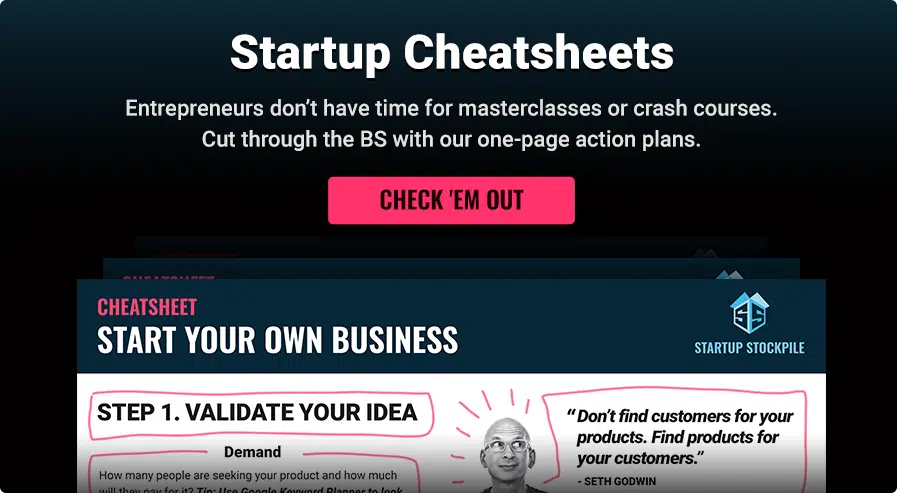Whether you’re a sales rep or startup founder, filling your sales pipeline is job one.
So how can you take your sales game to the next level and get the results you need?
Add these 8 sales tactics to your arsenal and start getting more leads, closing more sales, and building your book of business.
1. Get Right To The Point
How it works
Introduce yourself and your business as concisely as possible. Then move on to making your pitch, asking questions, and leaving space for your prospect to talk.
Create a script that eliminates lengthy introductions and extensive contextualization. Get to the point quickly so you don’t waste time on unnecessary tangents or distractions from your goal.
Why it works
Think of it as an elevator pitch. You only have a limited time to capture your prospects’ attention and sell your solution—even if they booked a 30-minute call.
After all, booking a call doesn’t mean you’re guaranteed a half-hour of undivided attention. If you don’t give prospects a reason to care from the very beginning of the call, they may tune out and cost you a conversion.
2. Sell The Solution
How it works
Make a list of your product or service’s main specs and features.
Next to each one, elaborate on the benefits. What pain point does each feature alleviate? What goal does it help your prospect achieve? These are the solutions you’re selling.
Then, choose the ones that best illustrate your unique selling proposition (i.e. how your product or service differs from the competition).
Why it works
In reality, you’re selling a product, service, or a combination of the two. But from your customer’s perspective, the product or service takes a backseat. Instead, they want a solution to their problems.
So while providing specs and discussing features is essential, it’s just as important to focus on the benefits. That’s why knowing your prospects’ pain points is key. When you know what they need most, you can paint a more compelling picture of your solution.
3. Ask Qualifying Questions
How it works
You could use digital cues or pre-call surveys to determine where prospects are in the sales process. But you don’t necessarily have to guess.
When you get on a call, ask prospects qualifying questions. Then, listen to them tell you exactly what they know, what they need, and what’s important to them. From there, you can fine-tune your pitch to suit them.
Why it works
If your team processes a lot of leads, it isn’t always easy to know exactly where each prospect sits in your sales funnel. When you prompt prospects to self-qualify, you can save everyone a lot of time and hassle.
With a little prompting, your prospects might even share their objections. That way, you can address potential issues before gearing the conversation back toward benefits and solutions.
4. Make It Awkward
How it works
Ask your prospects plenty of tough questions:
- What’s your business’s biggest challenge?
- What went wrong when you tried to do this in-house?
- What’s your budget for this project?
If they respond right away, great. But if they don’t have an immediate answer, wait. Don’t feel compelled to fill the silence. Let them process their thoughts without creating a distraction, even if it takes a few awkward moments.
Why it works
When you’re in sales, it’s natural to want to create a positive experience for your prospect. After all, you want them to trust your pitch and accept your offer.
After you ask a question, it’s ok if there’s an “awkward” silence. In most cases, you’re the only one who feels uncomfortable, as your prospect is busy formulating a response.
If it takes longer than a few seconds, follow up in a friendly way. Mention that you missed their response and repeat the question.
5. Guide Prospects Toward A Sale
How it works
Prompt your prospects to take the next step by guiding them toward the desired outcome. The keyword here is guiding. Instead of giving them a list of next steps or an aggressive pitch, make a suggestion or a recommendation to point them in the right direction.
Tell them what other people in their position have done, such as:
- “Most customers at your level choose our Premium package.”
- “I find that customers with your needs benefit most from our Superior product.”
- “Other customers considering our Ultimate service typically put down a $10,000 deposit.”
Why it works
By sharing what other customers have done, you provide social proof. You confirm that others have bought your product and service, boosting prospects’ confidence that they’re making a good decision.
6. Speak Your Clients’ Language
How it works
Review recordings of past client calls — both successful ones and those that didn’t work out. Make a note of how they speak about their needs and challenges. Then, borrow their phrasing to frame pain points and solutions for prospects.
Why it works
No one will ever understand your prospects the way their peers do. You can speak prospects’ language more effectively by re-purposing what they say.
That means you can tap into their pain points and goals more meaningfully. You can also position your company’s solution in a way that makes perfect sense.
7. Focus On The Future
How it works
Don’t save the price for the very end of your sales pitch. Instead, leave time for a more compelling conclusion.
Encourage your prospects to think about the future when they successfully resolve their challenges. Invite them to imagine their feelings when using your product or service.
Why it works
When you make a sales pitch, it’s tempting to save the price for last. It’s everyone’s least favorite part of a sales call, and bringing it up too soon can cause prospects to make up their minds quickly.
But when you end with money talk, that’s where prospects are likely to fixate. Concluding with a focus on the future helps avoid unnecessary pricing objections and can get more prospects to accept your offer.
8. Schedule Follow-Ups
How it works
Before you hang up, tell prospects approximately when you’ll follow up next. They’ll expect to hear from you, so your follow-up won’t surprise them.
Then, do exactly what you promised. Plan your next follow-up if your prospects are still in the decision-making process. Repeat again and again until you make the sale or they go another route.
Why it works
Stop assuming that you must close deals on the first attempt or that no sale now means no sale. Planning multiple touchpoints isn’t unusual, especially if you sell a high-ticket product or service.
Use your startup’s sales cycle data to determine how long most prospects take to decide. From there, pinpoint the ideal number of touchpoints and the best follow-up timing. Once you have a follow-up system, you can increase conversion rates and improve your sales process.
With these sales tactics at your fingertips, you’ll have the tools to get more leads and fill your pipeline. That means you can scale your startup and successfully take your business to the next level.
9. Use Empathy To Close
How it works
Step 1: Ask your prospects about their challenges and listen to their answers.
Step 2: Communicate your understanding of their current situation and what they need.
Step 3: Make a recommendation using the following statement, “Because you said [blank], I’d like to recommend [blank]. Does that make sense?”
And if the prospect says anything other than “no,” ask them, “What’s a good next step?”
Why it works
This approach makes your prospect feel like you understand their issues and uses questions/answers to advance the sale even if you don’t close.
It’s a softer way of using the If/Then Close that looks like this, “If we can do this based on what you just told me, then would you be willing to move forward?”
Related Articles
- 5 Tactics for Building a Bullet Proof Sales Pitch
- Sales Bots: A Quick Guide for Startups & Small Business Owners
- The 45 Best Email Marketing Tools & Services for Small Businesses
- 5 Reasons Recording Sales Calls is a VoC Copywriting Hack
- 5 KPI Measurement Tools You Can Use to Keep Your Business on Track
Editor’s Note: Want more handpicked content that’ll help you build your business? Subscribe to our monthly newsletter.






